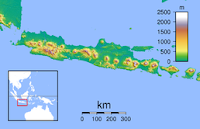This site displays the attribute as a place of activism or residential site, but the exact function has not been clearly known. [1] Ratu Boko is estimated to have used one in the 8th century during the dynasty Sailendra (Rakai Panangkaran) of the Kingdom Medang (Mataram Hindu). Judging from the pattern of laying the remains of the building, allegedly the site is the former palace (the king). This opinion is based on the fact that this complex is not a temple or a building with a religious nature, but rather a fortified castle with evidence of residual dry walls and trenches as defensive structures. [2] The remains of settlements are also found in the vicinity of this site.
The name "Queen Boko" is derived from local legend. Ratu Boko (Java language, meaning literally: "the king stork") is the father of Loro Jonggrang, which is also the name of the main temple complex of Prambanan Temple.Administratively, the site is located in the subdistrict of Prambanan, Sleman, Yogyakarta and lies at an altitude of nearly 200 m above sea level.
The site is to be nominated to the UNESCO World Heritage Site since 1995.
Ratu Boko site was first reported by Van Boeckholzt in 1790, which states there are archeological ruins on the hill Ratu Boko. This hill itself is a branch of the system Sewu Mountains, which stretches from south of Yogyakarta and the area Tulungagung. One hundred years later, led the new research conducted by FDK Bosch, which is reported in van Ratoe Boko Palace. From this it is concluded that the ruins are the remains of the palace.
Abhayagiri Vihara inscription which dates to 792 AD is a written document found on the site Ratu Baka. In this inscription mentions a character named Tejahpurnapane Panamkarana or Rakai Panangkaran (746-784 AD), and mentions a temple on the hill area called Abhyagiri Temple ("temple on the hill that is free from danger"). Rakai Panangkaran resigned as King for want of spiritual calm and concentrate on religious issues, one of them by establishing a named Abhayagiri Vihara temple in the year 792 AD Rakai Panangkaran embraced Buddhism as well as the building is called the Abhayagiri Vihara is a Buddhist background, as the evidence is the presence of Dyani Buddha statue. However, also found elements of Hinduism on the site of Queen Boko As Durga, Ganesha and Yoni.
Apparently, this complex is then converted into a palace for the king's bastion equipped subordinate (vassal) who named Rakai Walaing Kumbayoni Pu. According to the inscription Siwagrha this place called the fortifications consisting of hundreds of piles of stones by Balaputra. Building on the hill was used as a stronghold of the power struggle in the battle at a later date.
Inside the complex there are the former gate, Paseban room, pool, Hall, Pringgitan, princess, and two niches cave to meditate.









